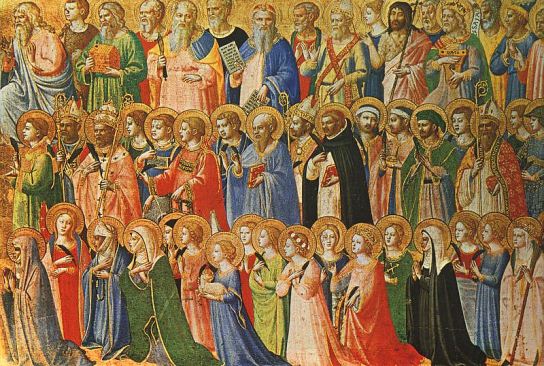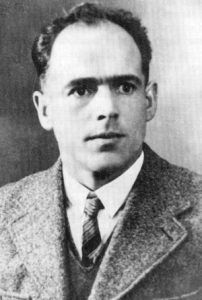 When my wife and I got married, we had the privilege of making a pilgrimage to Rome as our honeymoon trip. While in Rome, we saw a number of churches, but one in particular stood out to me: Chiesa del Gesu (The Church of Jesus; pictured right). In this beautiful old baroque church there is a unique relic: the forearm of St. Francis Xavier, the great Jesuit missionary. While visiting an altar with a body part on display may not seem too romantic for a date, let alone a honeymoon, it actually became one of the most romantic places of our honeymoon! Why? Because I realized before that altar that relics are an important cipher for understanding the vocation I embarked upon in marriage.
When my wife and I got married, we had the privilege of making a pilgrimage to Rome as our honeymoon trip. While in Rome, we saw a number of churches, but one in particular stood out to me: Chiesa del Gesu (The Church of Jesus; pictured right). In this beautiful old baroque church there is a unique relic: the forearm of St. Francis Xavier, the great Jesuit missionary. While visiting an altar with a body part on display may not seem too romantic for a date, let alone a honeymoon, it actually became one of the most romantic places of our honeymoon! Why? Because I realized before that altar that relics are an important cipher for understanding the vocation I embarked upon in marriage.
I admit that at the time of my visit I was “weirded out” by the presence of St. Francis Xavier’s forearm, and I was certainly not thinking at first about romance. But then as usual, God challenged my limited thoughts. As I prayed before the altar in Chiesa Gesu, I thought: “Why does the Church have altars with the body parts of the Saints? Is this some pagan ritual? Does this distract us or help us in loving Christ, to whom alone our worship is directed?” As I thought about it, I realized that this practice of venerating relics of a saint’s body is uniquely Christian, and that it does honor Christ. The key to understanding this ancient practice is to recognize that the Church honors the body – and by extension the body parts of the saints and certain items they touched – because of the Church’s belief in the Resurrection of the Body made possible by Jesus Christ’s own Resurrection. We honor the body parts of the Saints because one day their entire body will be glorified in the Resurrection of the Body. Their bodies are holy because they will give praise to God in Heaven. Thus, as I knelt before that altar in Rome, I came to understand that this practice of venerating bodily relics of the Saints is a witness to our belief in the Resurrection of Body, and that it chiefly points to Christ’s Resurrection, not away from Him.
Given this rootedness in the Resurrection, the altar enshrining St. Francis Xavier’s forearm reminded me of the purpose of my spouse’s human body – to be an everlasting temple of God. It is this recognition that helps guide marital romance: our bodies are temples of God by virtue of our baptism, and we are called to praise God in our bodies through virtue and the Sacraments (see Rom 12:1). Marital romance is called to be “romance within the Resurrection.” It is a romance that goes beyond simply asking whether or not a particular action violates a commandment given by God, like adultery or lust. It also asks every day whether or not this physical or verbal action treats my spouse’s body with the respect due to a “temple of God,” which it is in this life and the next. Therefore, far from drawing me away from Christ or the love of my spouse, the relic of St. Francis Xavier instead brought us closer by provoking the following questions: “Do I approach my spouse within the vision of God’s plan for our bodies, or do I disregard that plan because of laziness, selfishness, or ignorance? And am I treating my spouse with prayerful reverence as I would a bodily relic of a Saint?” Thus, while others were enjoying the beach on their honeymoon – which for the record we did later too – we were also blessed with romance in the most unlikely of all places, in front of a saint’s body part.
Want to strengthen your marital romance and vocation with your spouse? Then try praying before a relic of a saint! (Oftentimes a shrine to a particular saint will have a relic from that saint.) Before the relic, ask God to illumine both of your minds about the true nature of your bodies and how to treat your spouse’s body according to this divine destiny. Then keep learning about God’s divine plan for your marriage and recall this holy relic on many occasions to foster this awareness of our bodies’ destiny. Remember that we will always be learning about God’s plan for our marriage until the day we die, but let us with joy seek out this romance within the Resurrection, a romance that can even be found – nay especially found – before St. Francis Xavier’s forearm.
About the author
Daniel Meola is a PhD candidate at the Pontifical John Paul II Institute for Studies on Marriage and the Family in Washington, DC. He and his wife Bethany were married in May 2011.

 Born: 1207
Born: 1207
 St. Louis: August 22, 1823 – July 29, 1894
St. Louis: August 22, 1823 – July 29, 1894
 Born: January 28, 1572
Born: January 28, 1572 Born: May 20, 1907
Born: May 20, 1907 Born: February 7, 1478
Born: February 7, 1478
